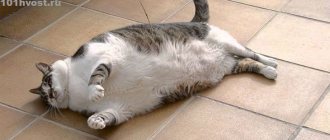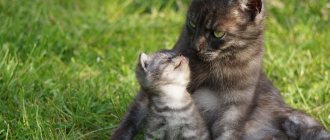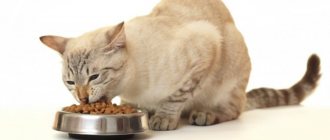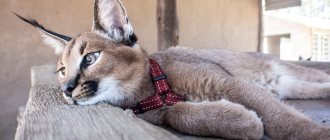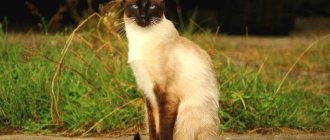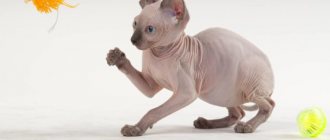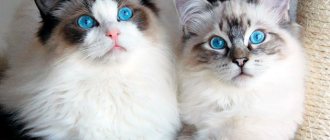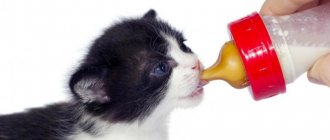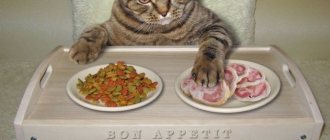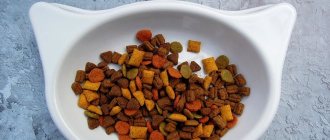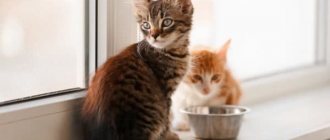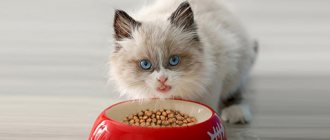Cats are carnivorous animals that prefer to eat several times a day, rather than just once, as in the wild. In addition, they do not eat more than they need. However, the amount of daily cat food depends on several factors, such as the animal's age, size, physical activity, or personality. We must provide them with a balanced and high-quality diet so that they do not gain excess weight or, conversely, suffer from malnutrition.
We will show you how to properly feed these pets depending on what stage of their life they are at and what the norm of cat food is. Remember that the daily amount of food for an adult cat will be different from the daily amount of food for a kitten or older cat.
Optimally suitable menu
Natural nutrition
How much and how to feed a cat depends not only on the age and physiological state of the animal, but also on the energy value of the food or natural products from which Murka’s diet is based. Typically, the average cat for every kilogram of weight should receive:
- at least 10 g of protein,
- up to 2 g fat,
- up to 3 g of carbohydrates (of which up to 0.4 g should be fiber)
- and various vitamin and mineral baits and supplements.
How much food a cat needs per day can be seen in the table (when feeding natural products - g/day):
| Product type | Adult cats | Kittens | ||||
| up to 1 month | 1-3 months | 3-6 months | 6 months and > | |||
| Meat and meat by-products | 80-120 | 8-10 | 10-60 | 60-80 | 80-100 | |
| Fish | 80-100 | 6-8 | 8-50 | 50-60 | 60-80 | |
| Milk | 100-200 | 20-30 | 30-100 | 100-130 | 130-150 | |
| Cottage cheese | 30-50 | 3,5 | 5-10 | 10-15 | 15-20 | |
| Groats | 50-80 | 10-20 | 20-50 | 50-70 | 70-80 | |
| Vegetables | 30-40 | 10-15 | 15-20 | 20-30 | 30-40 | |
| Animal fat | 5-8 | 1 | 1-2 | 3 | 3-4 | |
| Flour | meat and bone | 10-15 | — | 5-8 | 8-10 | 10-12 |
| fish | 8-12 | — | — | 3-5 | 3-5 | |
| bone | 8-10 | 1-2 | 2-5 | 5-7 | 7-8 | |
| Fish fat | 1,3 | 0,5 | 0,5-1 | 1-1,5 | 1-1,5 | |
| Chicken eggs, pcs. | 1-2 per week | |||||
Depending on the general needs, cat owners can create the menu for their pets themselves.
A few simple recipes for nutritious feeding:
- 1 recipe . Cook separately 2 kg of meat (beef, poultry, rabbit, turkey), 200 g of buckwheat or rice, up to 500 g of vegetables (turnips, broccoli, bell peppers, carrots). Grind everything through a meat grinder, season with olive oil (no more than 2 tablespoons) and a small amount of weak broth after cooking the meat. The resulting mixture is divided into portions (by weight it is good to correspond to 1 feeding) and frozen. This mixture is enough to feed an adult cat weighing up to 5 kg for a week.
- 2 recipe . Raw 150-200 g of vegetables, 1 kg of raw chicken fillet and up to 150 g of boiled rice are passed through a meat grinder. Meatballs are formed, boiled in boiling water for 10-15 minutes, cooled and frozen.
- 3 recipe . Cut into medium-sized pieces: 700 poultry or beef (50/50 is possible), 200 g chicken or beef hearts (an excellent source of taurine), up to 100 g liver (no more). Everything is filled with ½ cup of natural fiber and seasoned with 2 chicken yolks. The mixture is frozen in portions. Feed daily according to natural feeding standards. Be sure to defrost before serving.
You can create different quantities of such recipes yourself. In addition to the listed products, your diet should contain 20-30 grams of fermented milk products (kefir, fermented baked milk, low-fat cottage cheese) every day. Vitamin and mineral supplements can and should be added to the composition.
How much natural food should a cat eat? It should be no more than 7-7.5% of the cat’s total body weight.
| Cat weight | The daily portion of natural food should not exceed |
| With a cat weighing 4 kg | up to 300 g. |
| for pregnant | up to 350 g. |
| old cats | up to 200 g |
| kittens | 50-100 g. |
Of course, the figure is approximate and can vary in one direction or another, depending on the physiological state of the animal (illness or recovery from it, pregnancy, feeding kittens with breast milk, old cats, etc.).
When feeding natural products, the amount of water the cat drinks is from 70 to 80 ml .
Feeding dry food
How much dry food should I give my cat? Typically, on the packaging, each manufacturer always writes the daily consumption rate, which should be followed. If there is no information (for example, the food was purchased in bulk without packaging), then you should roughly adhere to the following scheme (taking into account the average quality of the food):
| Animal weight | Feed quantity |
| medium weight cats (up to 4 kg) | 40-70 g |
| pregnant women of average weight | 45-80 g |
| large individuals (4-6 kg) | 80-150 g |
| large pregnant cats | up to 200 g |
| kittens (1-2 kg) | 30-40 g |
| old individuals | up to 100 g |
These are very approximate standards that do not take into account the physiological state of the animal. If you are sick or breastfeeding, your portions will need to be adjusted. The composition of the feed also affects the amount of one-time and daily portions. Therefore, it is still recommended to find out how much dry food to give your cat per day, depending on its brand and nutritional value.
Animals that are on dry feeding should have free access to clean drinking water. The amount of water per day should be 3 times the weight of dry food consumed (for example, for 100 g of dry food, at least 300 ml of water should be drunk per day ).
When he was born
Feeding a newborn kitten is perhaps the only topic in nutrition that does not concern you at all.
His mother knows the answer to this question. But it happens that people also have to feed babies, for example, foundlings.
So what do you need to know if a baby is dropped at your door, or for some other reason, feeding a kitty falls on your shoulders.
A signal that the baby is completely full will be his quiet sleep. If after feeding the baby squeals, then eating should be continued.
Feeding wet industrial feeds
How much wet food should I give my cat? The basic rule of feeding remains the same here - we read the manufacturer’s recommendations and take into account the physiological state of the pet.
Wet food includes canned food (pates) and pouches (pieces of food in sauces or jelly). If the manufacturer does not indicate on the packaging how much wet food to give a cat per day, then the generally accepted norm is 5% of the total body weight.
It means that:
- for a pet weighing up to 3 kg per day, 100-150 g of food is enough;
- up to 5 kg - 225-250 g of feed, divided into the required number of feedings during the day;
- pregnant women of average weight (depending on breed and size) – 200-250 g.
Factors influencing diet
The body's need for more or less food directly depends on what physiological changes occur in it throughout life.
If you follow your pet's lead and give him food every time he asks, there is a risk of overeating, and as a result, obesity. Therefore, it is important for the owner to create a feeding schedule and monitor the pet’s weight. The serving size should always be the same and appropriate to the needs of the cat depending on its weight, age, breed, activity.
- We want to eat.
Attention! If your cat regularly leaves uneaten food, the portion size should be reduced.
After 15-20 minutes have passed after the animal is full, the bowl of food is removed and the remaining food is disposed of. The possibility of a cat being poisoned by a spoiled product must not be allowed. The dishes are washed and dried, preparing for the next feeding. There should always be a bowl of clean water near the food bowl, which is changed daily.
It is important to monitor the amount of water you drink, especially if your pet eats ready-made dry food. Often cats prefer to drink water from household utensils: buckets or basins. It is necessary to ensure that the water in such containers is always fresh and clean. Refusal to drink or excessive thirst is a reason to contact a veterinarian. Perhaps the food is not suitable for the animal, or it is possible that this is a symptom of a disease.
If a cat quickly absorbs food, but does not get enough, constantly begs for food, and does not gain weight, it is necessary to examine it for the presence of parasites.
In summer, a cat's appetite worsens due to the heat - the pet spends most of the day dozing, drinking water, eating little by little early in the morning and towards night. And in the fall, the predator’s appetite increases, because by winter it needs to gain weight and restore its coat.
A cat's health also affects its appetite. The need to take medications, their possible side effects, and the nature of the disease are factors that reduce a cat’s interest in food.
For feeding and drinking, it is best to use wide cups with low sides. If you are keeping several pets, dishes with food should be installed at different levels or in different rooms so that the animals eat calmly, do not rush and do not try to take food from each other.
How to tell if your cat has enough food
Why does an owner need to know how much food a cat needs per day? It's simple: you need to balance the amount of food in such a way that the pet has enough nutrients for life, but at the same time avoid overeating with excess weight and obesity or not leading to exhaustion. To control body weight, you can weigh your cat regularly. But this is quite troublesome, so it is better to control the amount of feed consumed from the very beginning.
If an animal does not have enough food, it will lose weight, its fur will become dull and begin to shed, it will constantly meow or look for ways to feed itself, for example, by pulling something off the table. In this case, the portion of food can be slightly increased.
You can determine the degree of fatness and weight standards by examining the cat and palpating its body.
| Condition level | External characteristics |
| lack of weight: |
|
| lower limit of normal: |
|
| normal weight: |
|
| excess weight: |
|
| signs of obesity: |
|
Constant access to food – is it possible or not?
Sometimes, due to the nature of the working day, pet owners cannot afford to feed them strictly according to the hour. The solution is found in the constant presence of food in the bowl throughout the day. Is it possible to do this or not? It is possible, but this method of feeding is only suitable for mentally balanced cats that do not have a tendency to overeat.
Having the unhindered opportunity to approach a plate of food at any time, it can be tempting to eat constantly until the dishes are empty, rather than as needed.
Only dry food is suitable for this feeding method :
- If Murka has an adequate appetite, you can pour in the entire daily portion of food at once in the morning and calmly leave the house.
- If you still have a tendency to overeat, take half the portion in the morning and the second half in the evening.
- If the owner leaves in the morning and does not know exactly when he will return, then 2/3 of the daily portion of food is immediately poured, and the remaining 1/3 is added in the evening.
This will not work with wet food, because... You can’t leave it in a cup for a long time because of the risks of rapid spoilage and indigestion later when eating it after some time.
This method of feeding is absolutely not suitable for kittens ! Kids are completely unaware of moderation and will eat as much as there is food on their plate. This is fraught with overeating with all the ensuing consequences (indigestion, constipation, flatulence).
Nutritional and energy needs of cats
What is the essence of feeding animals in general? To replenish the energy and nutrients needed to maintain their normal functioning. The needs for all this depend on many factors:
- body weight and constitution (the smaller the cat, the more intense its metabolism, because there is more energy loss due to the high ratio of body surface area to mass);
- gender and age (young animals need more than older animals, cats need more than cats);
- physiological condition (pregnant, lactating and sick animals have special needs);
- ambient temperature (the hotter it is, the less you want to eat).
Relationship between the quality of industrial feed and its quantity per feeding
- The higher the class of cat food, the richer and higher quality the protein it contains. In cheap food, the source of protein is mainly plant components, in expensive food it is animal, in very expensive food it is pure meat. Therefore, the cheaper the food, the more it needs to be given to the cat to replenish the daily protein requirement.
- The higher quality and more natural the food , the less various artificial additives it contains that enhance the smell and taste, add color and ensure long-term storage of preservatives. Because of this, it should not be surprising that cats are more willing to eat low-grade food than holistic food. However, if you immediately accustom the animal to good food, it will no longer eat bad food.
- The worse the food, the more extra “ballast” it contains from auxiliary components and the less useful it contains per 100 g of product. This “ballast” causes an increased and unnecessary load on the gastrointestinal tract. This means that, for example, an economy class food needs to be eaten by a cat from 130 to 200 g per day to get the full amount of proteins, fats and carbohydrates, while a luxury or holistic food needs only 45-60 g.
- Cheap feeds generally lack balance in vitamins and minerals If a cat's diet contains economy class food, then additional vitamins and minerals are required, i.e. these are additional costs. Expensive food is all-inclusive.
- High-quality food contains additional components that improve metabolism and stimulate the functioning of both individual organs and systems and the entire body as a whole.
- Expensive food of the highest classes has a high cost, but at the same time low daily consumption.
When converted to cheap products, but with high consumption, the difference in money is small, but in benefits it is colossal !
Rating
All wet canned food for cats can be divided into four classes: economy, premium, super-premium and holistic. It is clear that the meat content in them increases in ascending order. But not all cat lovers can afford anything other than economy class.
Popular brands of economy-class canned food: “Kiteket”, “Whiskas”, “Night Hunter”, “Felix”.
If we talk about the best wet food among the most budget options, then in terms of protein content, the leader, unsurprisingly, is Night Hunter. Felix is in second place.
In the premium segment, popular brands include Sheba, Proplan, Gourmet, Royal Canin, and Brit. Sheba, Proplan and Brit have approximately the same protein content - 30–34%.
Super-premium class includes foods such as Pronature Original, Gina, Bozita and others. If you choose them for your pet, then you don’t have to worry about making a mistake - they are all approximately the same in composition and the presence of nutrients.
The best foods in the holistic segment are Innova, Acana, Almo Nature, Farmina N&D, Pronature Holistic, Orijen. They are very expensive and contain a large percentage of meat.
General classification of industrial feeds and what is best to feed
Traditionally, absolutely all factory-produced feeds are divided into 4 main classes:
Economy
The cheapest group of feeds, containing the cheapest ingredients. In fact, all waste from the food industry is collected here; there is no meat here at all. The protein comes mainly from plants, which is completely unsuitable for cats. Such food, of course, will not cause much harm, but there will be no benefit from it either. In order for such food to be eaten, it is saturated with various taste and smell enhancers. The consumption of such a product is very high due to its low nutritional value per 100 g of weight and poor digestibility. If you choose between a balanced natural diet (roughly speaking, buckwheat with meat) and economy-class food, then it is better to opt for a natural diet.
| pros | Minuses |
| Price, minimum maintenance required for a cat. | There is no balance in the composition, the protein is vegetable, the only meat ingredients are offal and meat and bone meal, the high content of flavor enhancers and fragrances. |
Premium
The most common group of feeds, because Thanks to its composition, it can balance between feeds close to economy class and super-premium. There are also few meat products and many offal, but the raw materials have certificates confirming their quality. Plants usually guarantee the preservation of vitamins, minerals and enzymes.
Which of the foods in this group is good and which is not, you will have to determine on your own or with the help of a veterinarian. To do this, you need to compare the energy and nutritional composition with the amount of feed recommended by the manufacturer for daily consumption. For example, the protein value is declared, as in super-premium food, but the daily portion is large, as in economy food, which means that the protein component has a low quality amino acid composition, and the composition itself is oversaturated with other unnecessary additives.
| pros | Minuses |
|
|
Super premium
The name speaks for itself - it contains only high quality ingredients and natural origin. If turkey meat or beef meat is declared, then that is exactly what it will be. The result is protein with high nutritional value.
When feeding such food, there is no need to give cats additional vitamins or mineral supplements, everything is already here. This is a food with excellent digestibility, proteins, fats and carbohydrates available for digestion and an almost complete absence of taste and smell enhancers. All ingredients usually have quality certificates at the level of human food products. The cost of such feed is rather high, but the portion consumption is much lower - this also results in savings.
| pros | Minuses |
|
|
Luxury and holistic
Elite feeds that occupy a special niche in feed production in general. These are products with a unique, environmentally friendly and most natural composition aimed at maintaining and enhancing the health of cats. The ingredients include meat, vegetables, cereals, grains, and natural fiber with maximum balance and concentration of all essential nutrients, minerals and vitamins.
Full absorption. There are no special dietary or medicinal lines in this line of food, because... The manufacturer boldly declares that the cat will not get sick at all if it eats only these foods from early childhood.
The level of purification and preparation of ingredients is certified by the human food quality control program. The food is equated in terms of usefulness to that which the cat supposedly could receive in its natural environment.
This food has a very small portion consumption per day due to the maximum concentration of useful and necessary substances in 100 g of product. The kit always comes with a special measuring cup, on which there are various notes indicating how much food a cat can feed per day, depending on its weight and physiology at a given specific point in time.
| pros | Minuses |
| Very high price. |
Why can't you feed your cat dog food?
The only and most important reason for this is different metabolism and the need for certain energy substances. You need to clearly understand the difference between the food and diet of a cat and a dog.
What is the difference between cat and dog food?
- Dog food contains very little protein because... these pets do not have an urgent need for it. Cats need protein constantly and in large quantities. Dog foods contain more plant components and grains - things that cats have difficulty digesting or cannot digest at all.
- Cat food contains vitamin A, and dog food contains beta-carotene, from which vitamin A is synthesized by the body itself. If you feed your cat food that is not your own, then over time vitamin A deficiency may develop and vision problems may appear, hair will begin to fall out and the skin will peel/itch.
- Dog food does not contain taurine, because... the liver of these animals synthesizes it itself in the required quantities. In cats, the liver does not do this, and the need for taurine is enormous. Thanks to this amino acid, fats are processed, blood clotting factors work normally, and the nervous system, immune and cardiovascular systems function without disruption. Cat food contains much larger quantities of meat components.
Feeding any type of animal with “not your own” food can lead to a lack or excess of certain nutrients, which, in turn, will definitely cause health problems over time!
A little history
The production of pet food dates back to 1860. Then a simple American electrician named Spratt came up with a dog pie, which included wheat, vegetables and beef blood.
Probably, from these times the myth began that all food for cats and dogs is made from waste: horns and hooves, as well as sawdust or soybeans (at best).
Nowadays, a variety of multi-colored bags allows you to choose pate, jelly, and pieces in sauce for your pet.
What nutrients do cats need and why?
Protein
Cats have almost 3 times more need for protein than dogs; they really can’t live without it. In addition to the fact that mustachioed pets have an exceptional need for a constant supply of essential amino acids to the body, there is also a difference in protein metabolism. If there is a lack of protein in food, the liver will begin to consume it from the cat’s body, depleting it. In dogs, the speed and level of its decomposition reflexively decreases, due to which its preservation and need increase.
Such a high need is explained by the body’s constant need for essential amino acids - leucine, threonine, arginine, lysine, phenylalanine, etc. These substances are needed to maintain the normal condition of the coat, as well as for a sufficient amount of feline - a unique substance excreted in cats in the urine. There is especially a lot of it in cats - it is this that gives such a pungent smell to the urine of adult sexually mature individuals.
Another very important essential acid for Murok and Murzikov is taurine. It is synthesized in the body of dogs, but not in cats. This amino acid is absent in protein, but is found in muscle fibers of animal origin, i.e. meat is a pure protein product. Lack of dietary intake leads to disruption of the reproductive system, cardiovascular system and destruction of the retina. There are even special taurine deficiency syndromes associated specifically with disruption of the above-mentioned organs and systems.
Protein must be supplied to cats' bodies constantly! Source of protein for cats: meat, fish, dairy products. Source of taurine: meat and fish (mostly in turkey and raw tuna).
Fats
Not only the energy value of the food depends on this nutrient, but also its palatability for animals (of course, vegetable oil for a cat will be less attractive in smell and taste). In addition to energy, fats in the body perform two more very important functions - they dissolve fat-soluble vitamins into an easily digestible state and are a source of essential fatty acids. A cat's daily diet should contain at least 15% fat, and if it is a kitten, then all 20%.
Source: animal and vegetable fats.
Carbohydrates
They consist of difficult-to-digest (fiber) and easily-digestible (starch and sugar). Fiber is needed for physiologically normal fecal formation. With enough of it - as much as needed - the cat will never have constipation or diarrhea due to nutrition. An excess of easily digestible carbohydrates leads to obesity and can trigger the development of diabetes.
Cats should receive 0.32 g of fiber and no more than 2.7 g of easily digestible carbohydrates per kilogram of weight per day.
Source of carbohydrates for cats: cereals (buckwheat, rice), bran, honey. The fiber comes from the same place plus vegetables.
Minerals and vitamins
Like any living organism, cats also need vitamins and minerals. The need for these substances can be met with the help of special vitamin complexes and feed additives. There are several nuances: cats do not need vitamin C, because... They produce it in the liver, but they need direct vitamin A, not beta-carotene, because the transformation of one substance into another does not occur in their body. This means that you should not feed Murka citrus fruits during a cold, and carrots in the diet should be replaced with liver.
Author:
Grinchuk Ekaterina Andreevna veterinarian
Adult
Adult felines, starting at 6 months, eat much less frequently than their small cubs. However, their portions are getting larger.
The amount of food that is enough to keep an adult cat full is selected individually. The volume of food largely depends on the animal itself , on its mobility, its character, weight and many other factors. It also depends on what food you choose. But there are still generally accepted norms from which you can build.
- All cats need amino acids, which is why they prefer meat to other foods as food. When an animal gets the right amount of protein, it looks healthy and playful
- It's time to dispel the myth that cats need milk. Moreover, many adults, on the contrary, refuse milk, moreover, it can negatively affect their digestive system and cause stomach upsets. In general, your animal chooses independently whether to drink milk or not.
- Almost all cats love to eat fish, but this is not a product that is necessarily necessary in their diet. Furry friends need vitamin A, which they can get from both meat and fish.
- Cats should not eat raw meat and fish, as the product may be contaminated with parasites.
- The weekly diet must include several feedings of liver and chicken eggs.
- Despite the fact that meat and fish should predominate in the diet, you should not forget about grains. Along with the cereal, your pet will receive the necessary vitamin B
- It is necessary to feed the cat 2 - 3 times a day, at the same time, with equal portions of food.
- There should always be clean water available throughout the day
- An adult animal weighing 5 kg should receive 150 grams of protein and 50 grams of carbohydrate foods per day
- Sometimes pets ask to try foods that are not natural to them. These can be chocolates, cucumbers, apples, raw potatoes and much more. Don’t be in a hurry to get scared; most likely, he just wanted to try something new. Perhaps after the first test he will beg you for candy more than once, or perhaps he will never ask you again
- Feeding the cat in the morning and evening is a good option for both the owner and the animal itself.
